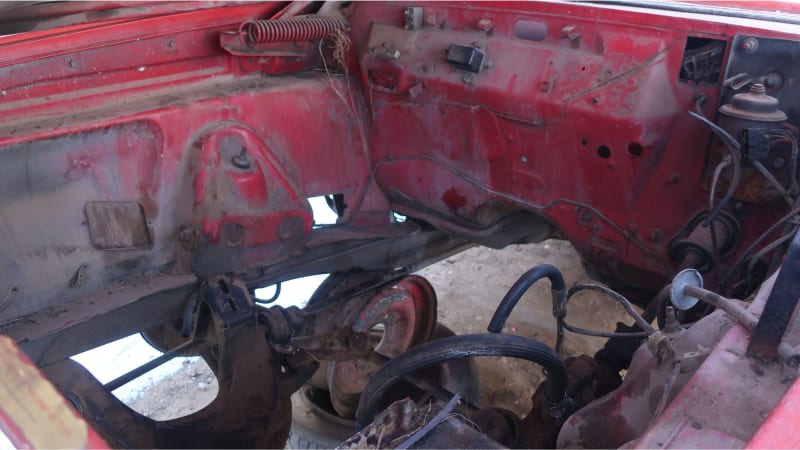Well into the 1970s, when you referred to a postwar American car as simply a “1971 Chevy” or “1953 Mercury,” everyone knew you meant the full-sized car made by the specified company, and model names for most of these cars simply designated the trim level. Eventually, some model names shoved all their siblings aside, as with the Impala or 300, but the system of numerous model names for the same car was in full swing in 1963 Detroit. In that year, your basic Dodge came in flavors ranging from the no-frills 330 all the way up to the loaded Polara 500. For today’s Junkyard Gem, we’ll travel to a yard in icy northeastern Colorado to visit a Polara hardtop that once stood just a single notch below the 500 on the ’63 Dodge Prestige-O-Meter.
In fact, car shoppers in 1963 could buy a larger car with Dodge badges — the 880, which was a no-hardtop-available machine based on a stripped-down Chrysler Newport — but the 330/440/Polara was considered the true ’63 Dodge of that year. With the compact Dart also available, model names became more important for understanding the family of vehicles being discussed, but this car is what most Americans meant when they said “it’s a ’63 Dodge two-door.”
The 1963 Polara rode on Chrysler’s then-new B Platform, a rear-wheel-drive unibody setup with torsion-bar front suspension in front and good ol’ leaf springs in the rear. The Duke Boys’ Charger was a B-body, as were the winged superspeedway monsters and Ricardo Montalban’s luxurious Cordoba. You can tell the regular Polara from the Polara 500 by the badge on the C pillar; if it’s this speedy-looking abstract shape, it’s the ordinary Polara.
This one had an MSRP of $2,732 when new, versus $2,245 for the very cheapest Dodge 330 post sedan (that’s about $23,400 and $19,240, respectively, in 2021 dollars). It appears to have had some attempts at restoration, but then the crash happened.
The base engine in the 1963 Polara was the 225-cubic-inch (3.8-liter) Slant-6 rated at 145 horsepower. Someone extracted the engine from this car before I got to it, but I feel confident in saying that it’s a near-certainty that it was one of the optional V8s available to the discerning Polara shopper. The sliced-off power steering hoses offer one clue; few cheapskate car shoppers in 1963 would have sprung for costly power steering without going for the V8 engine.
Then there’s the automatic transmission, controlled by the futuristic pushbutton shifter on the left side of the dash. A Slant-6-choosing penny-pincher who still wanted Polara prestige would have taken the base three-on-the-tree column-shift manual transmission. The most likely V8 would have been the 230-horse 318-cubic-inch (5.2-liter) plant, though big-block V8s could be had in displacements of 383 and 426 cubic inches (6.3 and 7.0 liters) and power output ranging from 305 to 415 hp. Keep in mind that those power numbers are the gross ratings then in use, subject to a certain amount of stretch in the hands of Detroit marketers, and that the 426 V8 is the one with wedge-shaped combustion chambers, not the mighty Hemi. Still, this car with a 426 Wedge would have been one serious factory hot rod when new, giving those heavier 409 Impalas a lot of problems at stoplight drag races.
Someone gave the front seats a makeover with red duct tape, and I don’t want to think about how itchy and horrible this must have been on a hot Weld County summer day.
Still, plenty of good suspension and trim pieces left to buy on this car, so let’s hope some Colorado/Wyoming/Kansas-based owners of early B-Bodies make a shopping trip here.
Close to six decades on the roads of the Front Range, and now it will be crushed here. I bought this dealer badge for my garage wall, of course.
In 1963, Dodge pitched the Dart as a “compact in large economy size” and the 330/440/Polara as a “standard-size” car. The 880 was such an afterthought that it didn’t make it into the ad; a few years later, the full-sized Dodge got the Monaco name.








